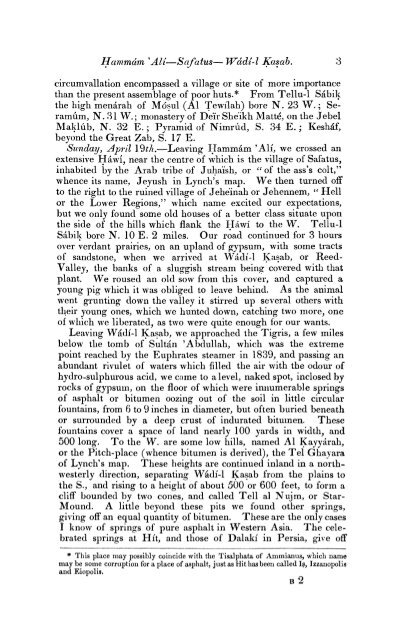Notes of an Excursion to Kal'ah Sherkat, the U'r of the Persians, and to
Notes of an Excursion to Kal'ah Sherkat, the U'r of the Persians, and to
Notes of an Excursion to Kal'ah Sherkat, the U'r of the Persians, and to
Create successful ePaper yourself
Turn your PDF publications into a flip-book with our unique Google optimized e-Paper software.
Hammam * 'Alz' Safatus-Wadi-l Kasab. * ?<br />
circumvallation encompasse(l a vil]age or site <strong>of</strong> more import<strong>an</strong>ce<br />
th<strong>an</strong> <strong>the</strong> presentassemblage <strong>of</strong> poorhuts.* From Tellu-l SAbik<br />
<strong>the</strong> high menarah <strong>of</strong> Mosul (A1 Tewltlah) I)(re N. 23 W.; Seramum,<br />
N. 31 W.; monastery <strong>of</strong> Deir Sheikh Matt4, on <strong>the</strong> Jebel<br />
Maklub, N. 32 ED.; Pyramid <strong>of</strong> Nimrud, S. 34 E.; Keshaf,<br />
beyond <strong>the</strong> Great Zab, S. 17 E.<br />
Sunday, April ]9tAl.- Leaving T-Tammam'Ali, we crossed <strong>an</strong><br />
extensive Hawl, near <strong>the</strong> centre <strong>of</strong> shich is <strong>the</strong> village <strong>of</strong> Safatus,<br />
inhabited by <strong>the</strong> Arab tribe <strong>of</strong> Juhaish, or "<strong>of</strong> <strong>the</strong> ass's colt,'?<br />
whence its name, Jeyush in Lynch's map. XVe <strong>the</strong>n turned <strong>of</strong>f<br />
<strong>to</strong> <strong>the</strong> right <strong>to</strong> <strong>the</strong> ruined village <strong>of</strong> Jeheinah or Jehennem, " Hell<br />
or <strong>the</strong> Lower Regions," which name excited our expectations,<br />
but we only founel some old houses <strong>of</strong> a better class situate upon<br />
<strong>the</strong> side <strong>of</strong> <strong>the</strong> hills which fl<strong>an</strong>k <strong>the</strong> Hawi <strong>to</strong> <strong>the</strong> W. Tellu-l<br />
Sabik bore N. 10 E. 2 miles. Our road continued for 3 hours<br />
over verd<strong>an</strong>t prairies, on <strong>an</strong> upl<strong>an</strong>d <strong>of</strong> gypsum, with some tracts<br />
<strong>of</strong> s<strong>an</strong>ds<strong>to</strong>ne, when we arrived at Wadi-l Kasab, or Reed-<br />
Valley, <strong>the</strong> b<strong>an</strong>ks <strong>of</strong> a sluggish stream beinX covered with that<br />
pl<strong>an</strong>t. We roused <strong>an</strong> old sow from this cover, <strong>an</strong>d captured a<br />
young pig which it was obliged <strong>to</strong> leave behin(l. As <strong>the</strong> <strong>an</strong>imal<br />
went grunting clown <strong>the</strong> valley it stirred up several o<strong>the</strong>rs with<br />
<strong>the</strong>ir young ones, which we hunted down, catching two more, one<br />
<strong>of</strong> which we liberate(l, as two were quite enough <strong>to</strong>r our w<strong>an</strong>ts.<br />
Leaving WA(li-l Kasab, we approached <strong>the</strong> Tigris, a few miles<br />
below tlle <strong>to</strong>mb <strong>of</strong> Sult<strong>an</strong> 'Ab(lullah, which was <strong>the</strong> extreme<br />
point reached ljy <strong>the</strong> Euphrates steamer in 1839, <strong>an</strong>d passing <strong>an</strong><br />
abllnd<strong>an</strong>t rivulet <strong>of</strong> waters which filled <strong>the</strong> air with <strong>the</strong> otlour <strong>of</strong><br />
hy(lro-sulphurous aci(l, we came <strong>to</strong> a level, nake(l spot, inclose(l by<br />
rocks <strong>of</strong> gypsuIll, on <strong>the</strong> floor <strong>of</strong> which were innumerable springs<br />
<strong>of</strong> asphalt or bitumen oozing out <strong>of</strong> <strong>the</strong> soil in little circular<br />
fountains, from 6 <strong>to</strong> 9 inches in diameter, but <strong>of</strong>ten lluried beneath<br />
or surrounded by a deep crust <strong>of</strong> in(lurated bitumen. These<br />
fountains cover a space <strong>of</strong> l<strong>an</strong>d nearly 100 yards in width, <strong>an</strong>d<br />
500 long. To <strong>the</strong> W. are some low hills, named A1 Kayyarah,<br />
or <strong>the</strong> Pitch-place (whence bitumen is derived), <strong>the</strong> Tel Ghaw-ara<br />
<strong>of</strong> Lynch's map. These heights are continue(l inl<strong>an</strong>d in a northwesterly<br />
(lirection, separating Wa(li-l Kasab from <strong>the</strong> plains <strong>to</strong><br />
<strong>the</strong> S., <strong>an</strong>d rising <strong>to</strong> a height <strong>of</strong> about 500 or 60() feet, <strong>to</strong> form a<br />
cliS bounded by two cones, <strong>an</strong>d called Tell al Nujm, or Star-<br />
Mound. A little beyond <strong>the</strong>se pits we found o<strong>the</strong>r springs,<br />
giving <strong>of</strong> <strong>an</strong> equal qu<strong>an</strong>tity <strong>of</strong> bitumen. These are <strong>the</strong> only cases<br />
T know <strong>of</strong> springs <strong>of</strong> pure asphalt in Western Asia. The celebratetl<br />
springs at Hit, <strong>an</strong>d those <strong>of</strong> Dalaki in Persia, gis7e <strong>of</strong>f<br />
* This place may possibly coirtcide with <strong>the</strong> Tisalphata <strong>of</strong> Ammi<strong>an</strong>us, which name<br />
may be some corruption for a place <strong>of</strong> asphalt, just as Hit has been calle(l Is, Izz<strong>an</strong>opolis<br />
<strong>an</strong>d F,iopolis.<br />
B 2

















